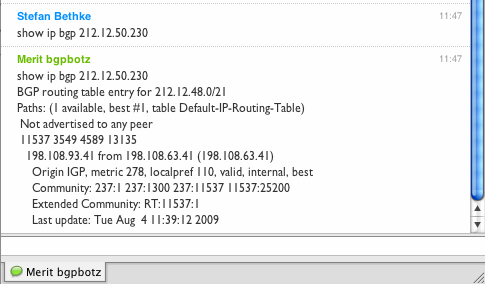When connecting via a Huawai E169 UTMS USB stick through O2 Germany’s network, the data stick or the network suggests a PPP IPCP remote address of 0.0.0.0. FreeBSD refuses to ifconfig the tun interface with this endpoint address.
Fortunately, ppp(8) offers a configuration parameter to influence the IP addresses negotiated with the peer (ifaddr), and suggesting a different address will make the configuration work.
If you get this log output from ppp, you need to configure address selection:
IPCP: deflink: RecvConfigAck(4) state = Req-Sent
IPCP: IPADDR[6] 10.68.235.57
IPCP: PRIDNS[6] 193.189.244.197
IPCP: SECDNS[6] 193.189.244.205
IPCP: deflink: State change Req-Sent --> Ack-Rcvd
IPCP: deflink: RecvConfigReq(47) state = Ack-Rcvd
IPCP: [EMPTY]
IPCP: deflink: SendConfigAck(47) state = Ack-Rcvd
IPCP: [EMPTY]
IPCP: deflink: State change Ack-Rcvd --> Opened
IPCP: deflink: LayerUp.
IPCP: myaddr 10.68.235.57 hisaddr = 0.0.0.0
Warning: iface add: ioctl(SIOCAIFADDR, 10.68.235.57 -> 0.0.0.0): Destination address required
Error: ipcp_InterfaceUp: unable to set ip address
Here’s my complete ppp.conf, with the ifaddr line included:
u3g:
set device /dev/cuaU0.0
set speed 115200
set ifaddr 10.0.0.1/0 10.0.0.2/0 255.255.255.0
set authname internet
set authkey internet
set log local phase ipcp
set dial "ABORT BUSY TIMEOUT 2 \
\"\" \
AT OK-AT-OK \
AT+CFUN=1 OK-AT-OK \
AT+CMEE=2 OK-AT-OK \
AT+CSQ OK \
AT+CGDCONT=1,\\\"IP\\\",\\\"internet\\\" OK \
AT+CGACT? OK-AT-OK \
AT+CGATT? OK \
AT+CGCLASS? OK \
AT+COPS? OK \
ATD*99***1# CONNECT"
set crtscts on
nat enable yes
add default HISADDR
disable dns
This applies to both 7-stable and 8-stable (with both the old and the new USB stacks). I’ve used u3g(4) on both occasions. The original ppp.conf for 3G modems is based off this one from Nick Hibma.
This is how it looks like when using ifaddr:
IPCP: PRIDNS[6] 10.11.12.13
IPCP: SECDNS[6] 10.11.12.14
IPCP: PRINBNS[6] 10.11.12.13
IPCP: MS NBNS req 130 - NAK??
IPCP: SECNBNS[6] 10.11.12.14
IPCP: MS NBNS req 132 - NAK??
IPCP: deflink: SendConfigReq(2) state = Req-Sent
IPCP: IPADDR[6] 10.0.0.1
IPCP: COMPPROTO[6] 16 VJ slots with slot compression
IPCP: deflink: RecvConfigReq(50) state = Req-Sent
IPCP: [EMPTY]
IPCP: deflink: SendConfigNak(50) state = Req-Sent
IPCP: IPADDR[6] 10.0.0.2
IPCP: deflink: RecvConfigRej(2) state = Req-Sent
IPCP: COMPPROTO[6] 16 VJ slots with slot compression
IPCP: deflink: SendConfigReq(3) state = Req-Sent
IPCP: IPADDR[6] 10.0.0.1
IPCP: deflink: RecvConfigNak(3) state = Req-Sent
IPCP: IPADDR[6] 10.42.237.110
IPCP: IPADDR[6] changing address: 10.0.0.1 --> 10.42.237.110
IPCP: deflink: SendConfigReq(4) state = Req-Sent
IPCP: IPADDR[6] 10.42.237.110
IPCP: deflink: RecvConfigAck(4) state = Req-Sent
IPCP: IPADDR[6] 10.42.237.110
IPCP: deflink: State change Req-Sent --> Ack-Rcvd
IPCP: deflink: RecvConfigReq(51) state = Ack-Rcvd
IPCP: [EMPTY]
IPCP: deflink: SendConfigAck(51) state = Ack-Rcvd
IPCP: [EMPTY]
IPCP: deflink: State change Ack-Rcvd --> Opened
IPCP: deflink: LayerUp.
IPCP: myaddr 10.42.237.110 hisaddr = 10.0.0.2
PPP ON freebsd-current>

